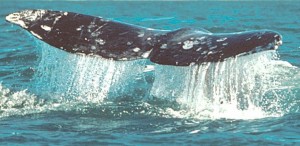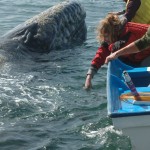A roundup on the 2011 season in West Cork…
The 2011 season kicked off with the most amazingly calm seas and lovely balmy weather, not really what you would expect for late March/early April off West Cork! These lovely conditions were accompanied by fabulous early sightings of adolescent minke whales moving well inshore to feed around the islands of Roaringwater Bay. We also had some of the earliest sightings of small groups of sub-adult common dolphins feeding in the sound between Cape Clear and The Fastnet Rock and Lighthouse. Frenetic reports of killer whale activity, possibly group feeding on a minke whale off The Mizen, early in April turned out to be a pod of around 50 Risso’s dolphins. Very easy to mistake them for killer whales with that disproportionately large dorsal fin. We encountered this species again during late April and May.
One memorable week in July stays with us when three minke whales commenced feeding close into the cliffs at the tip of Cape Clear Island affording us some lovely close encounters as we drifted, engines off. This “group” consisted of an adult, a sub adult and a calf which we think were related. The adult we believe was the mother of the sub-adult from a previous year while the juvenile was a youngster from the current year. We did not have hard evidence to support this other than the fact that we saw them together on several occasions throughout the season. This was some of the best minke whale watching we have had this year as we drifted on the ebbing tide watching these animals feeding beneath large flocks of Manx shearwaters and diving gannets, not more than a stones throw from the most southerly cliffs in Ireland.
Our West Cork leviathans, the mighty fin whale, put in an appearance during July feeding off their old haunts, The Galley Head and south of The Stag Rocks. This proved to be a rather short lived interlude but it was lovely to see the return of animals we have been following for the past several years through our non invasive photo ID project. The weather during the autumn, when we normally make a day long forays to the east to see this iconic species, hampered out efforts with gales setting in early September and not letting up much until the end of November. There is always next year! Whale watchers have to be the eternal optimists.
During the early fine weather we encountered some good sized basking sharks in the traditional haunts along the east coast of Sherkin Island, off Toe Head and throughout Roaringwater Bay, trawling for the phytoplankton blooms that occur in the shallow coastal waters during these early warm spells of weather. West Cork is one of the places where we encounter the unusual breaching behaviour in basking sharks and it is a spectacle to behold when these large four and five tonne animals launch themselves out of the water and create a splash like a depth charge going off when they re-enter the water. A sighting of a young basking shark during late August constituted a first for Whale Watch West Cork this year…this was the latest sighting of this species we have had off this part of West Cork during the last 10 years…normally basking shark activity has come to a stop by the middle of July.
One of the many highlights of the season was our numerous sightings of leatherback turtles we made off the islands between the Stag Rocks and The Mizen. The largest specimen we saw was over six feet long and the sight of these huge marine reptiles was a special treat as they are getting rarer and like so many marine species are under huge threat from the commercial fishing industry on a world wide basis, especially long line and gill net fisheries.
On the bird front we saw an increase in the numbers of Manx shearwaters, seeing increasing numbers as early as the first week of April and good numbers of juvenile gannets. Razorbill numbers during 2011 were up on previous years with the European guillemots and black guillemots maintaining their numbers. Puffin numbers still remain fairly low although sightings inshore rose slightly during 2011 on the previous few years. Although we suspect there may be a few breeding pairs of puffins on the islands along this part of the coast the absence of a significant breeding colony probably means that numbers will remain fairly sparce for this species in the immediate future.
With the memories of these lovely sightings during 2011 we look forward with anticipation to starting operations again during the last part of March 2012.
Tours depart at 9.30am, 2pm and 7pm daily from BALTIMORE HARBOUR. 4 hours tours and 2 hour tours. 7 days a week.
ENDS


Speak Your Mind